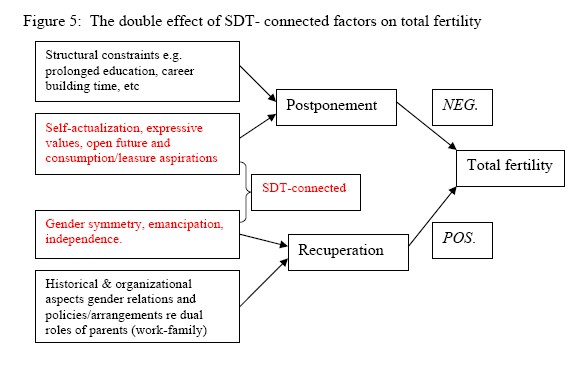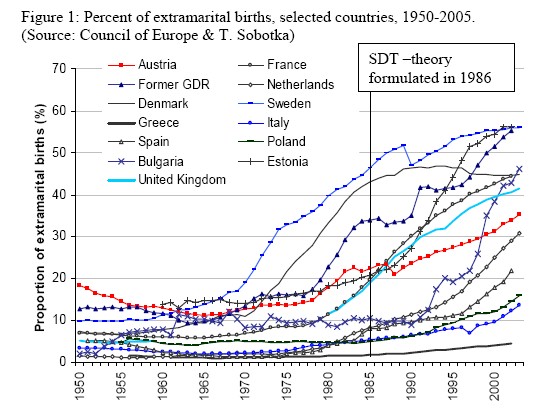http://www.imdb.com/title/tt0066434/quotesMemorable
quotes for
THX 1138SRT:
How shall the new
environment be programmed? It all happened so slowly that most men failed to
realize that anything had happened at all. They have a name
for the phenomenon -
SDT - Second Demographic
TransitionA must read:http://sdt.psc.isr.umich.edu/pubs/presentations/Unfolding_2010.pdf
 The
Unfolding Story of the Second Demographic Transition
The
Unfolding Story of the Second Demographic Transition.
Ron
Lesthaeghe
Royal Belgian Academy of Sciences.Paper to be
presented at the Conference on “Fertility in the History of the 20th
Century
– Trends, Theories, Public Discourses, and Policies.”
Akademia
Leopoldina & Berlin-Brandenburgische Akademie.
Januari 21-23,
2010.
Abstract.
This paper presents a narrative of the
unfolding of the Second Demographic Transition (SDT) since the theory was first
formulated in 1986. The first part recapitulates the foundations of the
theory, and documents the spread of the SDT to the point that it now covers most
European populations. Also for Europe, we focus on the relationship between the
SDT and current period fertility levels. It is shown that
the positive
relationship between these two is not a violation of the SDT-theory, but the
outcome of a “split correlation” with different sub-narratives concerning
fertility postponement and recuperation respectively for two parts of
Europe.
The second part of the paper addresses the issue of whether the
SDT has spread or is currently doing so in industrialized Asian countries.
Evidence gathered for Japan, South Korea, Hong Kong, Singapore and Taiwan is
being presented. That evidence pertains to both the macro-level (national trends
in postponement of marriage and parenthood, rise of cohabitation) and the
micro-level (connections between individual
values orientations and
postponement of parenthood). Strong similarities are found with SDT-patterns in
Southern Europe, except for the fact that parenthood is still very rare among
Asian cohabiting partners.
...
The first signs of the SDT emerge already
in the 1950s: divorce rates were rising, especially in the US and Scandinavia,
and the departure from a life-long commitment was justified by the logic that a
“good divorce is better than a bad marriage”. Later on and from the second half
of the 1960s onward, also fertility started falling from its overall “baby boom”
high. Moreover, the trend with respect to ages at first marriage
was reversed
again, and proportions single started rising. Soon thereafter it became evident
that premarital cohabitation was on the rise and that divorce and widowhood were
followed less by remarriage and more by post-marital cohabitation. By the 1980s
even procreation within cohabiting unions had spread from Scandinavia to the
rest of Western Europe. Both France and the UK now have more than 40 percent
of
all births occurring out of wedlock. In 1960 both had 6
percent.
The notion of a second demographic transition,
introduced in 1986 by Dick van de Kaa and myself in a short article in
the Dutch sociology journal “Mens en Maatschappij”, has been criticized from
different angles.
First, the SDT would merely be the continuation of the
one and only transition (e.g. Cliquet, 1992).
Second, according to David
Coleman (2003), it would not be a “second transition”, but merely a “secondary
feature”. The SDT would, still according to Coleman, not even be demographic in
nature, but only a “partial analysis of life style preferences”.
Third,
a more common argument, particularly in the 1990s, has been that the SDT is an
archtypical Western European (+ Canadian, Australian) feature which would not
spread to the US nor to Southern, Central and Eastern Europe.
Instead,
the demographic changes in the latter parts of Europe could be accounted for by
the economic crisis associated with the transition from Communist to market
economies, without involving the operation of a cultural shift at all.
In the US, solid Christian values would stem the tide and
strengthen American “exceptionalism” as for instance exhibited by the absence of
sub-replacement fertility. Fifth, it was suggested that the
SDT overemphasized the link between the transformation in family relationships
(especially cohabitation) and the prevalence of sub-replacement fertility. Along
the same path, the SDT theory could not account for the great variety of levels
of fertility from barely below replacement to “lowest low”. And finally,
questions inevitably arose about the universality of the SDT: could its features
spread further to Asia or other continents as societies grow richer and initiate
a Maslowian preference drift?
Or is the SDT merely a western idiosyncracy
and bound to remain only that?
These six questions set the agenda for the
present paper.
...
The SDT starts with a multifaceted revolution, and
all aspects of it impact on fertility.
Firstly, there was a
contraceptive revolution with the invention of the pill and the reinvention of
IUDs. All of these were perfected very rapidly, and particularly
hormonal contraception was suited for postponing and spacing purposes. A.J.
Coale’s 1974 “learning curve” of contraception, which was monotonically
increasing with age and which fitted the FDT experience so well, was no longer
applicable in the West. After an interim period with increased incidence of
“shotgun marriages” (often 1965-75), the use of highly efficient and reliable
contraception starts at young ages and permits postponement of child-bearing as
a goal in its own right.
Secondly, there was also a sexual
revolution, and it was a forceful reaction to the notions that sex is confined
to marriage and mainly for procreation only. The younger generations
sought the value of sex for its own sake and accused the generation of their
parents of hypocrisy. Ages at first sexual intercourse decline during the SDT.
Thirdly, there was the gender revolution. Women were no longer
going to be subservient to men and husbands, but seize the right to regulate
fertility themselves. They did no longer undergo the “fatalities of
nature”, and this pressing wish for “biological autonomy” was articulated by
subsequent quests for the liberalization of induced abortion. Finally, these
“three revolutions” fit within the framework of an overall rejection of
authority and of a complete overhaul of the normative structure. Parents,
educators, churches, army and much of the entire State apparatus end up in the
dock. This entire ideational reorientation, if not revolution, occurs during the
peak years of economic growth, and
shapes all aspects of the
SDT.
The overall outcome with respect to the SDT fertility
pattern is its marked degree of postponement. Mean ages at first
parenthood for women in sexual unions rise quite rapidly and to unprecedented
levels in several Western European populations.
The net outcome
is sub-replacement fertility: without the ethnic component (such as Hispanics
and Blacks in the US or Maoris in New Zealand) all OECD countries have
subreplacement fertility....
The SDT, on the other
hand, is founded on the rise of the “higher order needs” as is defined by Maslow
(1954). Once the basic material preoccupations, and particularly that
of long term financial security, are satisfied via welfare state provisions,
more existential and expressive needs become articulated. These are centered on
selfactualization in formulating goals, individual autonomy in choosing means,
and
recognition for their realization. These features emerge in a variety of
domains, and this is why the SDT can be linked to such a wide variety of
empirical indicators of ideational change.
In the political sphere such
higher order or “post-materialist” (Inglehart, 1970) needs deal, inter alia,
with the quest for more direct, grassroots democracy, openness of government,
rejection of political patronage, decline of life-long loyalty to political or
religious pillars (= “depillarization”), and the rise of ecological and other
quality rather than quantity oriented issues on the political agenda. The
downturn of it all is
rising distrust in politics and institutions and
growing political anomy that can fuel right wing extremism.
The state is
no longer viewed in terms of a benign provider, but again more as an Orwellian
“big brother”. A corollary thereof is the disengagement from civic,
professional and community oriented networks (e.g. Putnam, 2000).
...
5.
Can the SDT also spread to non-Western populations?
At present everyone has
come to terms with the fact that the FDT is a worldwide phenomenon. Furthermore,
everyone equally realizes that the FDT can take-off at just about any level of
economic development, and in strictly rural as well as urban societies. But,
will the SDT be equally universal? Or indeed, as David Coleman expects, remain a
regional idiosyncrasy? Obviously, if we wish to address this
question
on a global scale, we can only speculate about the probabilities of such a
“universal” diffusion, in the same way that one could only speculate in the
1950s and 1960s about the eventuality of pervasive fertility control emerging in
the then developing countries. However, if we are looking for SDT evidence
beyond the European cultural spheres but in countries that are wealthy enough to
have undergone
some Maslowian drift, we may indeed find suitable testing
grounds. Several industrialized and urbanized Asian countries are therefore of
direct relevance.
Before considering the detailed evidence, one should be
reminded of the fact that the SDT diagnosis requires the presence of several
features:
(i) Sub-replacement fertility is not enough, but must be linked to
postponement;
(ii) Ages at marriage must rise and reflect a growing
prominence of free partner
choice and female autonomy;
(iii) Premarital
cohabitation must become more common and more acceptable.
(iv) Not only
evidence at the macro-level must be mustered, but also at the
individual
level connections between the demographic features and values
orientations must
exist.
Note, however, that the demographic
characteristics of the SDT features are not necessarily occurring
simultaneously, but that lags are likely to emerge. Premarital cohabitation and
parenthood among cohabitors, for instance, typically constitute lagging
features, since they often run counter to existing moral codes (cf. supra
RWAmodel applied to US and Belgium).
...
At this point,
we
feel sufficiently secure about the fact that several advanced Asian populations
have joined the set of SDT countries, since all characteristics except
for one (procreation among cohabitants) have emerged. Moreover, the scarce Asian
micro-level data for Japan, South Korea and Singapore are in line with what was
repeatedly found in the European examples.
Admittedly it will remain
difficult to make a neat separation between the effects of structural factors
and ideational ones respectively on marriage postponement and low fertility. But
that has never been easy, not even in the case of the FDT, in the first instance
because these sets of factors are often causally interconnected.
Furthermore,
one should also realize that mass media are producing a
“world culture” in which individual autonomy and self-actualization have a very
prominent, if not dominant place, and that these provide both motivations and
justifications for the onset of the SDT. Political,
religious and ideological backlashes are of course always possible (e.g. both
Christian and Muslim fundamentalist reactions), but at least up till now the
experience has been that such reactions have not been strong enough to cause
decisive trend reversals in countries with democratic
credentials.  Author Topic: Brainwashed -
Sub-Replacement Fertility - The Second Demographic Transition (Read 46047
times)
Author Topic: Brainwashed -
Sub-Replacement Fertility - The Second Demographic Transition (Read 46047
times)